Contents
What’s the first thing that comes to mind when you hear the word “Viking“? A savage horde, probably wearing horned helmets (which isn’t historically accurate!), plundering the land with axes in hand… But what if I told you that this image is one of history’s greatest injustices? What if we told you that those labeled “barbarians” were actually the most skilled sailors, the most daring explorers, the most cunning traders, and one of the most complex social structures of their time—the epic Vikings?
In this article, we’ll set aside the superficial image created by popular culture and delve deep into the world of the real Vikings: why and how they burst onto the scene, how they changed the world, and the rich legacy they left behind.
Fasten your seat belts, because we’re embarking on one of the most exciting voyages in history, aboard dragon-headed ships.
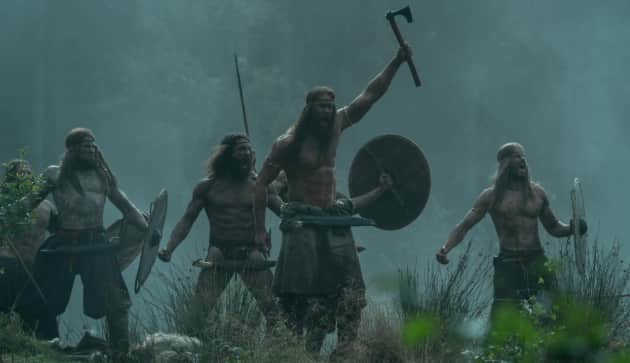
Where It All Began: Cold Lands and Ascension
Our story begins in the late 8th century in Scandinavia, that cold and rugged landscape encompassing present-day Denmark, Norway, and Sweden. How did these people, who had lived largely isolated from the outside world, engaged in agriculture and fishing for centuries, suddenly become Europe’s worst nightmare? Historians attribute this sudden boom to several key factors. The first was a growing population and a shortage of farmland. Young and ambitious men no longer had a future in their own lands; they had to look beyond the sea for wealth and fame.
The second, and perhaps most important, factor was the revolution in maritime technology. They invented those incredible vessels they called “longships,” which were both shallow-bottomed enough to navigate rivers and flexible enough to withstand the ocean’s massive waves. These vessels were fast, maneuverable, and frighteningly silent. This superior ship design was the secret to their ability to appear unnoticed on the shores of a monastery or a town.
A third reason was Europe’s internal weakness. The fragmentation of the Frankish Empire and the constant warring among England’s petty kingdoms left them incapable of an organized defense. Monasteries, in particular, were the Vikings’ first and easiest targets because they were both vulnerable and filled with valuables. The famous raid on Lindisfarne Abbey in England in 793 is generally considered by historians to mark the beginning of the Viking Age.
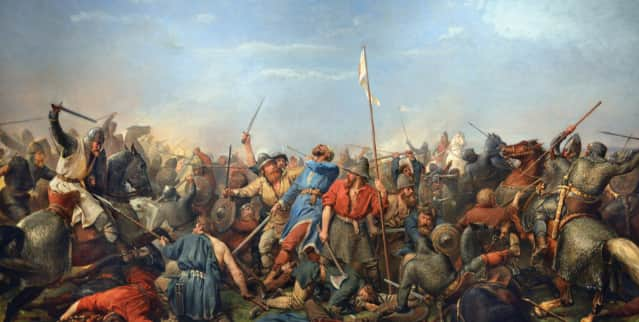
The First Raids and the Age of Ascension
These first raids were not just plundering, but also a message: “We have come, and nothing will ever be the same again.” These people did not call themselves “Vikings”; the word was an Old Norse verb meaning “raid” or “expedition.” For them, this was a profession; setting sail in the summers to “go Vikings” was a career path. This new career path, promising fame, wealth, and land, quickly attracted thousands of young Scandinavians.
In conclusion, the Vikings’ sudden rise was no coincidence; it was the result of a perfect storm of social, economic, and technological factors. Unable to fit into their confined world, these people, thanks to their superior technology and the crisis facing Europe, emerged onto the historical stage in an unforgettable way.
Vikings, Rulers of the Seas: Plunder and Trade
While the Vikings are often associated with “plunder,” this is only part of their story. Yes, in their early days, they were ruthless warriors and raiders. They repeatedly raided the coasts of England, France, and Ireland; they even laid siege to Paris, fought the Andalusian Umayyads in Spain, and reached as far as the Mediterranean. Over time, however, they not only plundered but also began to trade and even settle in the places they visited. They were shrewd traders, known for their bargaining skills as much as their swords.
They brought back not only gold and silver, but also valuable goods such as slaves, furs, and ivory. Through the trade networks they established, they exchanged these goods for luxury goods from Byzantium and even the Abbasid Caliphate. Arab dirhams found in Sweden during archaeological excavations provide concrete evidence of the widespread trade network they established. The foundations of many important European cities, such as Dublin and York, were laid by the Vikings as trading centers.
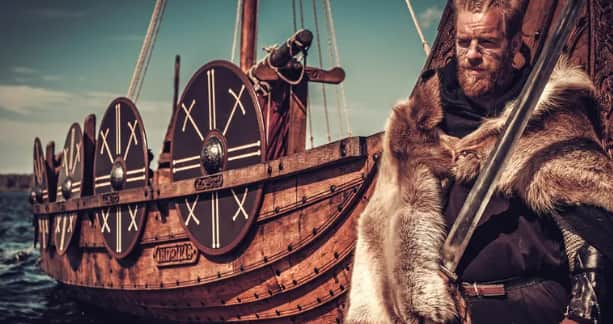
But what truly made the Vikings unique in history was their incredible passion for exploration. They were intrepid explorers who pushed the boundaries of the known world, curious about what lay beyond the horizon. In the 9th century, they braved the raging waves of the Atlantic, reaching and settling first in the Faroe Islands, then Iceland and Greenland. This was a feat that seemed nearly impossible with the technology of the time. On the open seas, they could only navigate by following the sun, stars, and coastlines.
Leif Erikson Discoveries
The pinnacle of these explorations was the arrival of a group of Vikings led by Leif Erikson in North America in the early 1000s, approximately 500 years before Christopher Columbus. The settlement they established in Newfoundland, Canada, which they named “Vinland,” is the ultimate testament to their foresight and courageous seafarers. Although this settlement was not permanent, this success demonstrates that the Vikings’ spirit of exploration knew no bounds.
In short, the Vikings were not one-dimensional characters. Depending on the situation, they could transform into a ruthless warrior, a cunning trader, or a daring explorer. This adaptability and risk-taking courage explain why they remained one of the most influential forces in world history for nearly three centuries.
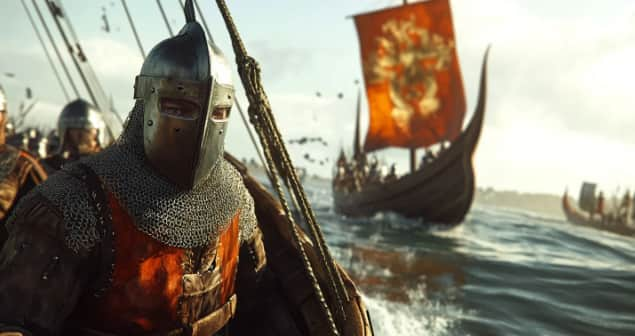
Shield Wall: Society, Culture, and Mythology
So, what enabled them to be so successful and organized? Contrary to popular belief, Viking society was not a rambunctious barbarian horde. On the contrary, it possessed its own unique laws, social structures, and rich culture. The society consisted of noble leaders called “jarls,” free farmers/traders called “karls,” and slaves called “thralls.” Decisions were made in assemblies called “things,” which were open to all free men. This demonstrates the existence of a primitive understanding of democracy.
Viking women enjoyed considerable freedom and rights compared to their contemporaries. They could own property, divorce, and fully assume the management of their families and lands when their husbands went on campaign. While the existence of warrior women such as “shield-maidens” is historically controversial, evidence found in sagas and tombs indicates that women held a highly respected and powerful position in society.
Their literature and art were also highly developed. They passed down long, complex prose poems called “sagas,” filled with tales of heroism, family, and revenge, through oral tradition. Using their own alphabet called “runes,” they carved their victories and important events into stones and monuments. Their mastery of metal and woodwork can be seen in their ships, weapons, and jewelry. They were also skilled craftsmen.
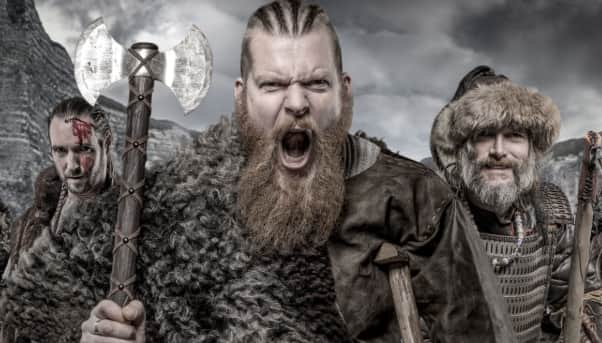
Vikings Mythology and Ragnar Lothbrok
Of course, to understand Viking culture, one must delve into their world of beliefs—that is, their rich and complex Viking mythology. This mythology, starring gods and goddesses like Odin, Thor, Loki, and Freya, shaped their perspective on life. The belief that a warrior who died heroically in battle would ascend to Odin’s palace, Valhalla, and fight alongside the gods at Ragnarök, the end of the world, gave them their renowned fearlessness and warrior spirit.
Figures like the legendary leader Ragnar Lothbrok, frequently encountered in popular culture, are semi-legendary heroes, informed by both historical reality and these mythological tales. His stories and those of his sons demonstrate the Vikings’ high regard for values such as honor, fame, and vengeance. This rich culture and belief system was the unifying force behind the shield wall.
Conclusion: The End of the Vikings Age
How did the Vikings Age end? The strengthening of European kingdoms, the establishment of more organized armies, and the Vikings’ conversion to Christianity and settlement led to the decline of that old raiding spirit. The Battle of Stamford Bridge in 1066 is generally considered the end of this era. But their legacy never ended. The cities they founded, the trade routes they opened, and, most importantly, the words they contributed to our languages and cultures remain with us today. They are even said to have influenced Magna Carta.
The Vikings are one of history’s most inspiring stories of entrepreneurship, showing us how a crisis (lack of land) can be transformed into an opportunity (navigation) and how courage, technological innovation, and strategic thinking are vital to navigating uncharted waters. They were true trailblazers, building their own career paths from scratch with an axe and a ship.
#vikings
#vikingshistory
